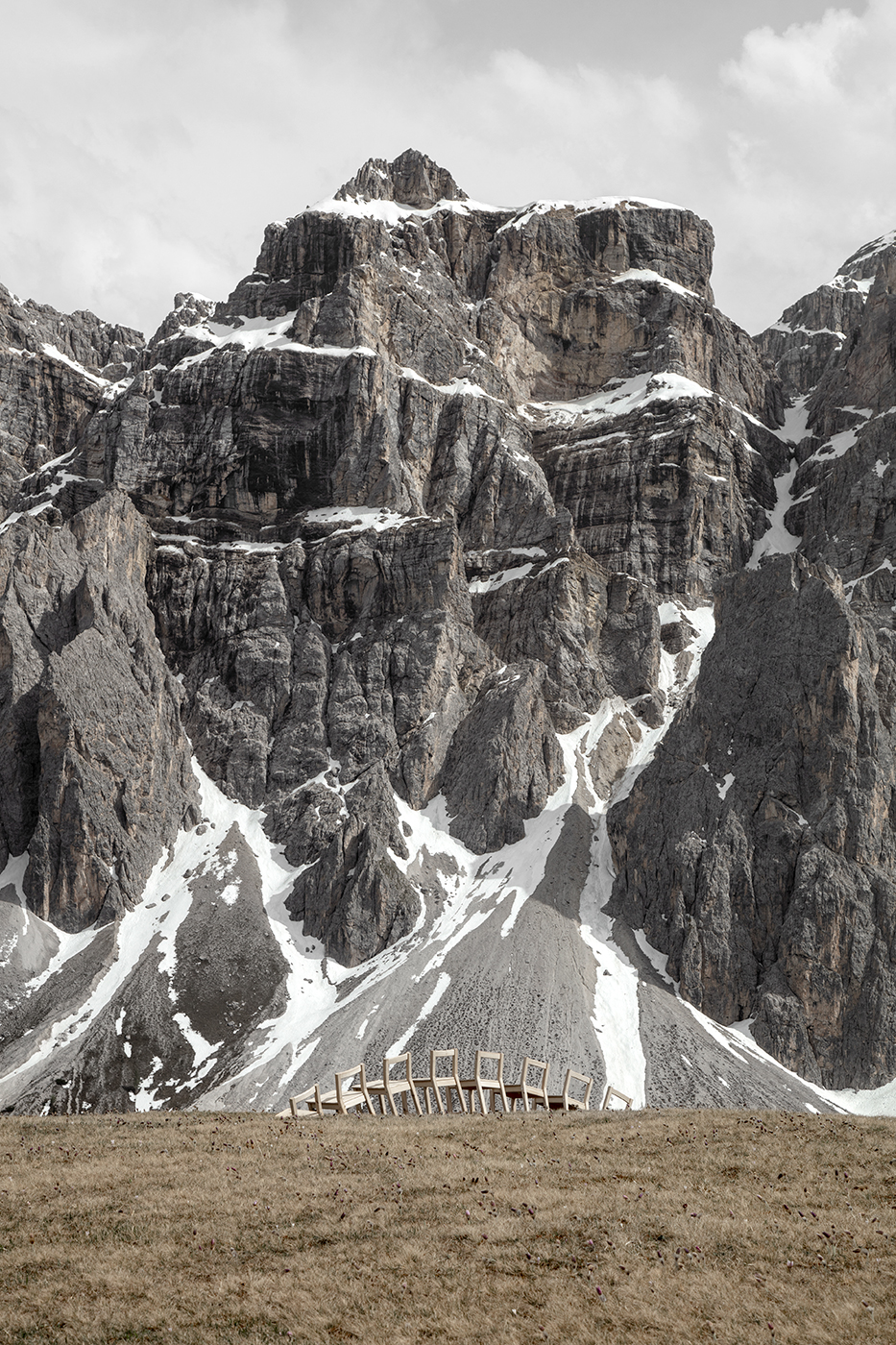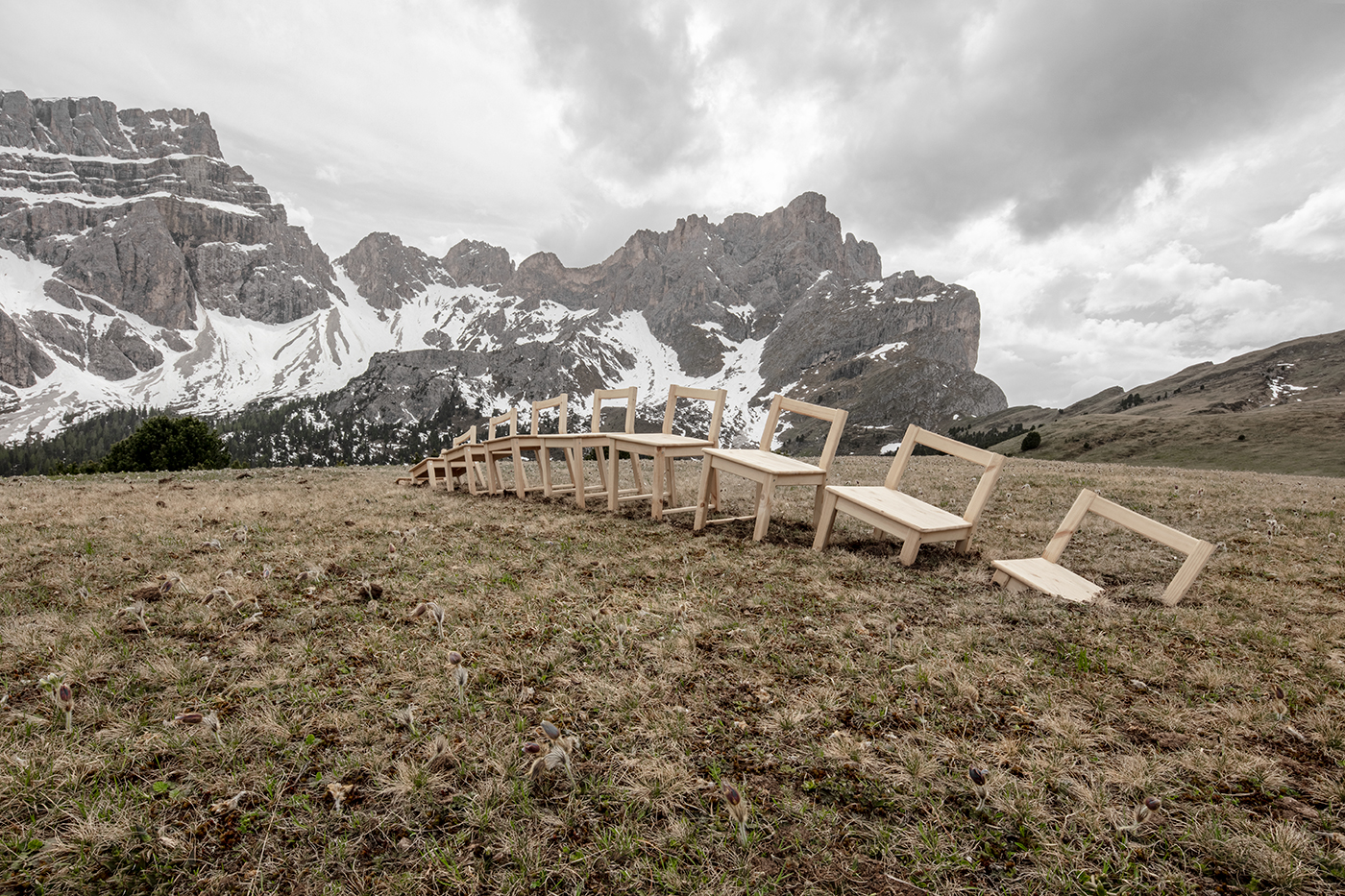ANUAR PORTUGAL, “JUNÍN”.
Mexico City, Mexico.
Location Munt d’Adagn, Lungiarü.
An interactive installation - nine suitably truncated chairs are arranged in such a way that the seats form an arch. The spectator can choose which chair to sit on and the reception will vary according to the location of the work: on the slope of a hill, for example, the most stable and straight chair will be one of those cut off upstream and not the obvious central choice positioned on the flat.
The chairs converge several elements that allude to a delimiting and exclusive concept of Heimat - they are partially embedded in the ground and thus evoke the roots that bind each of us to our origins; moreover, the chair is also the linguistic root of sedentariness, which is the basis of a precise and restrictive feeling of belonging. Sitting down to rest on one of these chairs will catalyse sensations that will perhaps tend to be nostalgic, evoking traditional type memories - the return to one‘s roots is in fact also suggested by the title of the work, homonymous with a poem by Borges that speaks of the return to the city of his grandfather
〉 Ladin
Istalaziun interativa – nü scagns taiá ia te na manira che les sëntes forma n arch. Le spetadú pó chirí fora sön ciun se senté y la sensaziun che al ará depenará dala colocaziun dl’opera: sö por le rogn de n col, por ejëmpl, sará le scagn taié ia a munt chël plü stabil, deperpo che chël zentral, sará le scagn da sté plü saurí y stabil te na colocaziun tl plan.
I scagns rapresentëia deplü elemënc che fej referimënt a n conzet de Heimat dai confins tlers y esclusifs – i scagns é ficiá ite tl terac y simbolisëia les raisc che nes liëia a nosta proveniënza; implü é le scagn n simbol dl ester aciasá, che é la basa de n sentimënt de portignënza tlera y strënta. Se senté sön un de chisc scagns por palsé fajará pó ester gní sö sensaziuns de incherscimun, recorc da plüdadî – le jí derevers ales raisc vëgn ince evoché tl titul dl’opera, le medemo titul de na poesia de Borges che baia dl jí zoruch tla cité dl nene.
〉 Italiano
Installazione interattiva - nove sedie opportunamente troncate sono disposte in modo tale che i sedili formano un arco. Lo spettatore può scegliere su quale sedia prendere posto e l’accoglienza varierà in base alla collocazione dell’opera: sul pendio di una collina, ad esempio, la sedia più stabile e diritta sarà una di quelle mozzate a monte e non quella centrale preferibile in pianura.
Le sedie fanno convergere più elementi che alludono ad un concetto di Heimat delimitante ed esclusivo – sono conficcate parzialmente nel terreno ed evocano così le radici che legano ognuno di noi alle proprie origini; inoltre sedia è anche radice linguistica della sedentarietà, la quale sta alla base di un sentimento di appartenenza precisa e restrittiva. Sedersi per riposare su una di queste sedie catalizzerà sensazioni che forse tenderanno nostalgiche verso ricordi atavici – il ritorno alle radici è infatti anche suggerito dal titolo dell’opera, omonimo a una poesia di Borges che parla del ritorno nella città del nonno.
〉 Deutsch
Eine interaktive Installation, bei der neun entsprechend verkürzte Stühle so angeordnet sind, dass sie einen Bogen bilden. Der Zuschauer kann wählen, auf welchem Stuhl er sitzen möchte. Die Beliebtheit der Stühle variiert je nach Aufstellungsort des Werks: Am Hang eines Hügels zum Beispiel werden die zum Berg hin geneigten Stühle bevorzugt und nicht der Stuhl in der Mitte, dem in der Ebene der Vorzug gegeben wird.
Die Stühle vereinen mehrere Elemente, die auf ein limitierendes und abgrenzendes Konzept von Heimat anspielen - sie sind teilweise in den Boden vertieft und deuten so die Wurzeln an, die jeden einzelnen von uns an seinen Ursprung binden; außerdem ist „Sitzen/Sessel“ auch die sprachliche Wurzel der Sesshaftigkeit, die die Grundlage für ein präzises und restriktives Zugehörigkeitsgefühl bildet. Wenn man sich zum Ausruhen auf einen dieser Stühle setzt, werden Empfindungen geweckt, die bisweilen in einem Anflug von Nostalgie atavistische Erinnerungen aufkommen lassen. Die Rückkehr zu den Wurzeln wird nicht zuletzt durch den Titel des Werkes suggeriert, das auch einem Gedicht von Borges den Namen gibt und von der Rückkehr seines Großvaters in seine Stadt handelt.
EXHIBIT SPACE
Munt d’Adagn, Lungiarü - Every three years, men from Val Badia's twelve villages walk in procession to the old Jeunn bishop's see, which is now a monastery, located above the small town of Chiusa, in Val di Isarch. The pilgrimage is a tradition going back over the centuries and leads the faithful from Val Badia on a three-day hike that crosses the valleys and mountain ridges. Some pilgrims arrive in the neighbouring valley, Funes, crossing the "Ju de Furćia" (the "cross" mountain ridge, also known as S. Zenon pass) at 2,293 m thorough the path of the Munt d’Adagn, which is a beautiful panoramic spot with green meadows in summer and white snow in winter.
〉 Ladin
Munt d’Adagn, Lungiarü - I omi y jogn dla Val Badia va da cënć agn incà vigni trëi agn en Jeunn. I badioć che vëgn da Juel caijö tol le tru cuntra Munt d’Adagn y passa sö por la Forcela da Furćia (2.293 m) iaijö Fonès, olache al röia adöm cun i Maroi y chi dla Val Badia Mesana. La Munt d’Adagn é n bel post panoramic con de bi prà floris d’isté y en bel mantel blanch d’invern.
〉 Italiano
Monte Adagn, Longiaru - Uomini e giovani dei dodici paesi della Val Badia si incamminano ogni tre anni in processione verso l’antica sede vescovile di Sabbiona, oggi un monastero, che si trova sopra la cittadina di Chiusa, in Val d’Isarco. I pellegrini arrivano nella vicina valle di Funes attraversando il Ju de Furcia (Giogo della Croce / Forcella S. Zenon) a 2.293 m sul sentiero verso il Monte Adagn. Il Monte Adagn è un luogo panoramico circondato da prati in fiore in estate e da un bel manto bianco in inverno.
〉 Deutsch
Munt d’Adagn, Kampill - Alle drei Jahre findet die Prozession der zwölf Gadertaler Gemeinden zum alten Bischofssitz Säben oberhalb von Klausen statt. Der Bittgang der Männer dauert drei Tage lang und wandern über das Ju de Furćia (Kreuzjoch - Forcella S. Zenon, auf 2.293 Metern) durch das Villnöss-Tal in Richtung Munt d’Adagn, die Wiesen des Naturparkes Puez-Odles.




